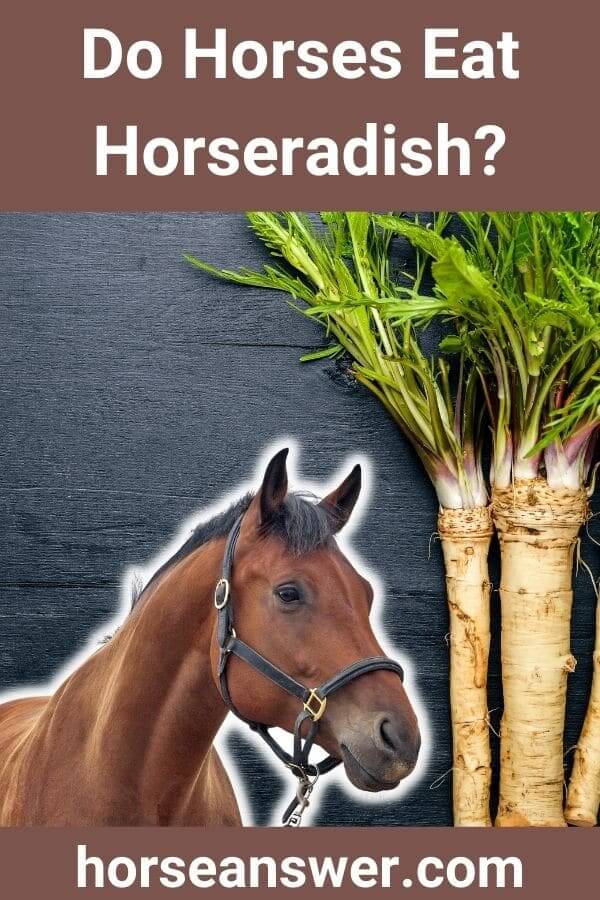Do Horses Eat Horseradish? (Find Out!)
No, horses do not eat horse radish. The plant from which the sauce is derived is inedible in its natural form—only be grinding up the roots do we get something edible. There are no natural wellsprings of horseradish from which wild horses eat. the word horse in this context simply means large and coarse.
So, we do not give horseradish its name because it is eaten by horses in the wild.
Indeed, most of us understand horseradish to mean a sauce, and do not realize it is derived from a plant with the same name.
This plant is inedible in its natural state so, no, horses do not eat it.
But can they?
Let’s look into it.

Can horses eat horseradish?
The simple answer is no.
Horseradish is incredibly dangerous for a number of reasons, so if you wanted to give the plant to your horses, you shouldn’t.
It’s highly toxic and dangerous.
Horseradish, in its original form, is a rough, bulky plant.
Even in the wild if horses were to come across a horseradish plant, they would not eat it.
Its large leaves are not edible, and horses typically skip leaves in favor of grass, anyway.
So, no, horses cannot eat horseradish.
The original question, of course, was do they eat horseradish, to which the answer is also no.
They would never eat it by choice, and trying to force your horse to eat something is always a losing battle.
We are all, typically, much more familiar with horseradish in its sauce form, though.
This is certainly how we were introduced to it.
So, is horseradish sauce safe for horses?
Can horses eat horseradish sauce?
Again, unfortunately not.
A good rule of thumb is that anything as cooked and processed as horseradish sauce is will not be safe for a horse, and there are much better options to give it a treat.
Horseradish sauce is no different from the plant itself, and is not edible by horses.
It comes with all the same problems as the plant, and is potentially very dangerous for your horse.
I’ll get into why exactly shortly, but it’s probably a good idea to presume that your horse cannot eat any kind of sauce.
Again, don’t be fooled by the horse in the name.
We use the word horse in the names of many things to convey a very particular meaning.
Let’s look at precisely what we mean by this in the case of horseradish.
Why is it called horseradish?
There is a simple answer to this, and the same thing is seen played out many times in other foods and creatures.
When we put the word horse before something, it is often before an example of something of which there are many varieties.
Radishes, for example.
There are many different kinds of radish, and so in this case, we are describing a large, harsh, coarse radish.
The root of the plant is like ginger, very thick, firm, and rough.
It’s also very, very large compared with most other kinds of radish.
This is why we use the word horse.
Horses, some would say, are not only very large and rough but also harsh and difficult to move.
This is all we mean by horseradish—nothing to do with actual horses.
Is horseradish toxic?
To livestock, yes. To horses, certainly.
As I said, the raw material of horseradish is a harsh, rough plant, so they will virtually never eat it of their own accord.
Even if they found it in the wild, they would likely know to ignore it.
That said, horseradish poisoning does happen.
Some horses are just too curious and have to try everything.
Horseradish converts a number of the ingredients present in the plant into mustard oil, which is toxic for horses. this is what makes horseradish toxic to horses and indeed to many other kinds of livestock.
Keep this in mind, then—if you find horseradish on your pasture, remove it just to be safe.
So, just forget any associations you had in your mind between horseradish and actual horses.
Think of a mighty horse, so large and powerful—this is all we try to invoke by calling the plant horseradish.
Anytime something in nature is referred to in this way—horseflies, horseradish—we just mean that this example of a particular thing is much larger than any point of comparison we might have.